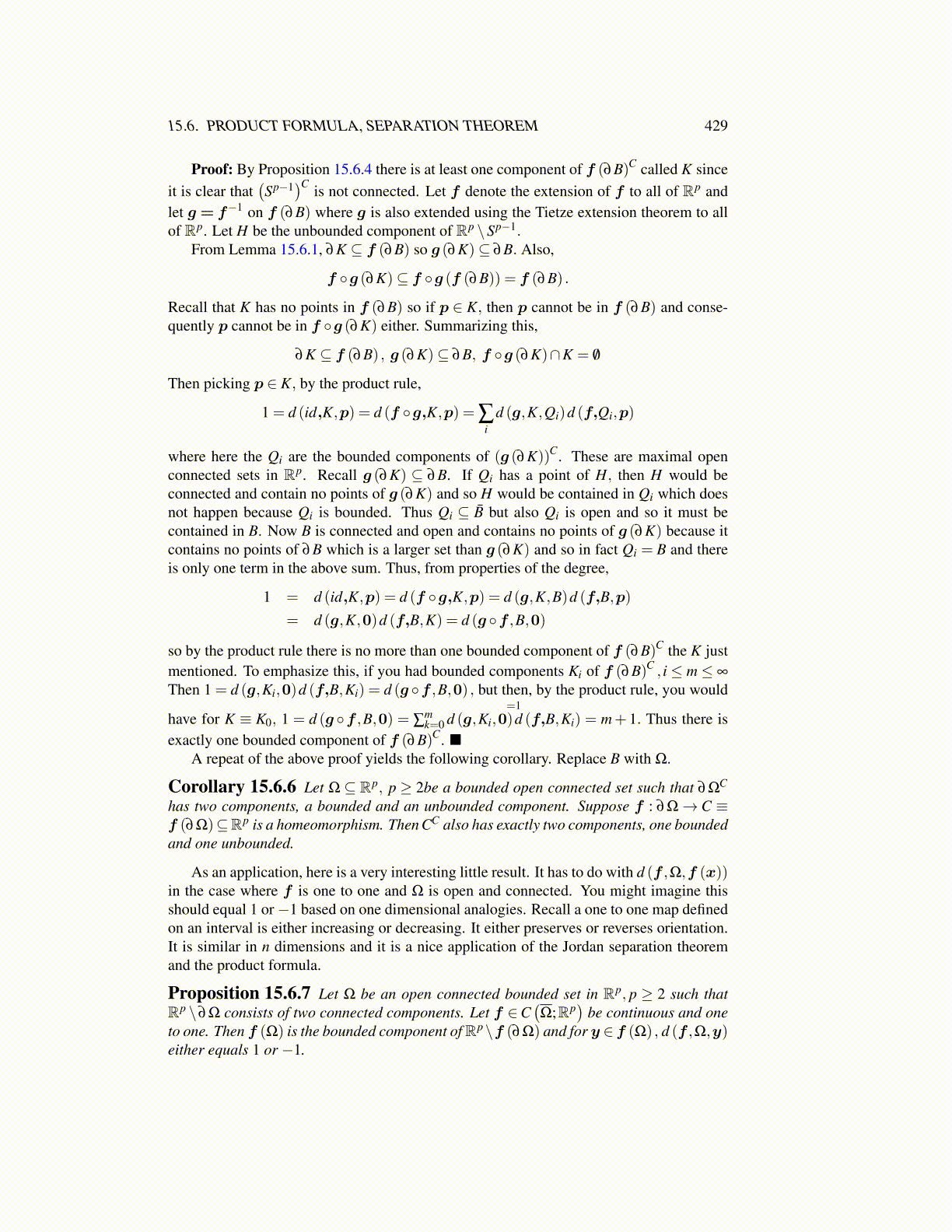
15.6. PRODUCT FORMULA, SEPARATION THEOREM 429
Proof: By Proposition 15.6.4 there is at least one component of f (∂B)C called K sinceit is clear that
(Sp−1
)C is not connected. Let f denote the extension of f to all of Rp andlet g= f−1 on f (∂B) where g is also extended using the Tietze extension theorem to allof Rp. Let H be the unbounded component of Rp \Sp−1.
From Lemma 15.6.1, ∂K ⊆ f (∂B) so g (∂K)⊆ ∂B. Also,
f ◦g (∂K)⊆ f ◦g (f (∂B)) = f (∂B) .
Recall that K has no points in f (∂B) so if p ∈ K, then p cannot be in f (∂B) and conse-quently p cannot be in f ◦g (∂K) either. Summarizing this,
∂K ⊆ f (∂B) , g (∂K)⊆ ∂B, f ◦g (∂K)∩K = /0
Then picking p ∈ K, by the product rule,
1 = d (id,K,p) = d (f ◦g,K,p) = ∑i
d (g,K,Qi)d (f,Qi,p)
where here the Qi are the bounded components of (g (∂K))C. These are maximal openconnected sets in Rp. Recall g (∂K) ⊆ ∂B. If Qi has a point of H, then H would beconnected and contain no points of g (∂K) and so H would be contained in Qi which doesnot happen because Qi is bounded. Thus Qi ⊆ B̄ but also Qi is open and so it must becontained in B. Now B is connected and open and contains no points of g (∂K) because itcontains no points of ∂B which is a larger set than g (∂K) and so in fact Qi = B and thereis only one term in the above sum. Thus, from properties of the degree,
1 = d (id,K,p) = d (f ◦g,K,p) = d (g,K,B)d (f,B,p)
= d (g,K,0)d (f,B,K) = d (g ◦f ,B,0)
so by the product rule there is no more than one bounded component of f (∂B)C the K justmentioned. To emphasize this, if you had bounded components Ki of f (∂B)C , i ≤ m ≤ ∞
Then 1 = d (g,Ki,0)d (f,B,Ki) = d (g ◦f ,B,0) , but then, by the product rule, you would
have for K ≡ K0, 1 = d (g ◦f ,B,0) = ∑mk=0
=1d (g,Ki,0)d (f,B,Ki) = m+ 1. Thus there is
exactly one bounded component of f (∂B)C. ■A repeat of the above proof yields the following corollary. Replace B with Ω.
Corollary 15.6.6 Let Ω ⊆ Rp, p ≥ 2be a bounded open connected set such that ∂ΩC
has two components, a bounded and an unbounded component. Suppose f : ∂Ω→ C ≡f (∂Ω)⊆Rp is a homeomorphism. Then CC also has exactly two components, one boundedand one unbounded.
As an application, here is a very interesting little result. It has to do with d (f ,Ω,f (x))in the case where f is one to one and Ω is open and connected. You might imagine thisshould equal 1 or−1 based on one dimensional analogies. Recall a one to one map definedon an interval is either increasing or decreasing. It either preserves or reverses orientation.It is similar in n dimensions and it is a nice application of the Jordan separation theoremand the product formula.
Proposition 15.6.7 Let Ω be an open connected bounded set in Rp, p ≥ 2 such thatRp \∂Ω consists of two connected components. Let f ∈C
(Ω;Rp
)be continuous and one
to one. Then f (Ω) is the bounded component ofRp\f (∂Ω) and for y ∈ f (Ω) , d (f ,Ω,y)either equals 1 or −1.